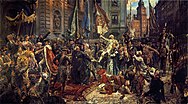Welcome to the Poland Portal — Witaj w Portalu o Polsce

From Polish history –
Selected image –

Did you know –
- ... that the Equality Parade (pictured) held annually in Warsaw since 2001, is the oldest pride parade in any former Eastern bloc country?
- ... that about 3,500 Jews from the Pińsk Ghetto and from nearby Kobryń were murdered at Bronna Góra in June 1942?
- ... that Florian Znaniecki, a Polish American philosopher and sociologist, coined the terms " culturalism" and " humanistic coefficient"?
- ... that the Polish Armed Forces in the West contributed one division to Operation Overlord, the largest seaborne invasion in history?
You can help!
Selected biography –
Selected location –
Poland now
Recent events
- On 9 July, Jerzy Stuhr (pictured), a prominent theatre and film actor and director, died at the age of 77.
-
Poland at the 2024 European Athletics Championships:






- On 10 June, Natalia Kaczmarek won a gold medal in 400-meter dash.
- On 9 June, Wojciech Nowicki won a gold medal in hammer throw.
- On 9 June, the ruling Civic Coalition won the European Parliament election in Poland.
- On 8 June, Polish tennis player Iga Świątek won the 2024 French Open, her fifth Grand Slam singles title.
Ongoing
Constitutional crisis •
Belarus–EU border crisis •
Ukrainian refugee crisis •
Polish farmers' protests
Holidays and observances in July 2024
(statutory public holidays in bold)
- Battle of Grunwald anniversary (reenactors pictured), 15 July
Subcategories
Topics
Related portals
|
|
|
|
|
|
|
|
| Belarus | Czech Republic | Germany | Lithuania | Russia | Slovakia | Ukraine |
|
|
|
|
|
| Europe | Catholicism | Communism | European Union |
Associated Wikimedia
The following Wikimedia Foundation sister projects provide more on this subject:
-
Commons
Free media repository -
Wikibooks
Free textbooks and manuals -
Wikidata
Free knowledge base -
Wikinews
Free-content news -
Wikiquote
Collection of quotations -
Wikisource
Free-content library -
Wikiversity
Free learning tools -
Wikivoyage
Free travel guide -
Wiktionary
Dictionary and thesaurus
Wikipedias in the languages of Poland
|
|
Kaszëbskô Wikipedijô Kashubian Wikipedia |
|
Polska Wikipedia Polish Wikipedia |
|
Ślůnsko Wikipedyjo Silesian Wikipedia |
|
Wymysiöeryś Wikipedyj Vilamovian Wikipedia Incubator |
Беларуская • Česky • Deutsch • Հայերեն • Lietuvių • Romani • Русский • Slovenčina • Українська • ייִדיש
Welcome to the Poland Portal — Witaj w Portalu o Polsce

From Polish history –
Selected image –

Did you know –
- ... that the Equality Parade (pictured) held annually in Warsaw since 2001, is the oldest pride parade in any former Eastern bloc country?
- ... that about 3,500 Jews from the Pińsk Ghetto and from nearby Kobryń were murdered at Bronna Góra in June 1942?
- ... that Florian Znaniecki, a Polish American philosopher and sociologist, coined the terms " culturalism" and " humanistic coefficient"?
- ... that the Polish Armed Forces in the West contributed one division to Operation Overlord, the largest seaborne invasion in history?
You can help!
Selected biography –
Selected location –
Poland now
Recent events
- On 9 July, Jerzy Stuhr (pictured), a prominent theatre and film actor and director, died at the age of 77.
-
Poland at the 2024 European Athletics Championships:






- On 10 June, Natalia Kaczmarek won a gold medal in 400-meter dash.
- On 9 June, Wojciech Nowicki won a gold medal in hammer throw.
- On 9 June, the ruling Civic Coalition won the European Parliament election in Poland.
- On 8 June, Polish tennis player Iga Świątek won the 2024 French Open, her fifth Grand Slam singles title.
Ongoing
Constitutional crisis •
Belarus–EU border crisis •
Ukrainian refugee crisis •
Polish farmers' protests
Holidays and observances in July 2024
(statutory public holidays in bold)
- Battle of Grunwald anniversary (reenactors pictured), 15 July
Subcategories
Topics
Related portals
|
|
|
|
|
|
|
|
| Belarus | Czech Republic | Germany | Lithuania | Russia | Slovakia | Ukraine |
|
|
|
|
|
| Europe | Catholicism | Communism | European Union |
Associated Wikimedia
The following Wikimedia Foundation sister projects provide more on this subject:
-
Commons
Free media repository -
Wikibooks
Free textbooks and manuals -
Wikidata
Free knowledge base -
Wikinews
Free-content news -
Wikiquote
Collection of quotations -
Wikisource
Free-content library -
Wikiversity
Free learning tools -
Wikivoyage
Free travel guide -
Wiktionary
Dictionary and thesaurus
Wikipedias in the languages of Poland
|
|
Kaszëbskô Wikipedijô Kashubian Wikipedia |
|
Polska Wikipedia Polish Wikipedia |
|
Ślůnsko Wikipedyjo Silesian Wikipedia |
|
Wymysiöeryś Wikipedyj Vilamovian Wikipedia Incubator |
Беларуская • Česky • Deutsch • Հայերեն • Lietuvių • Romani • Русский • Slovenčina • Українська • ייִדיש





























